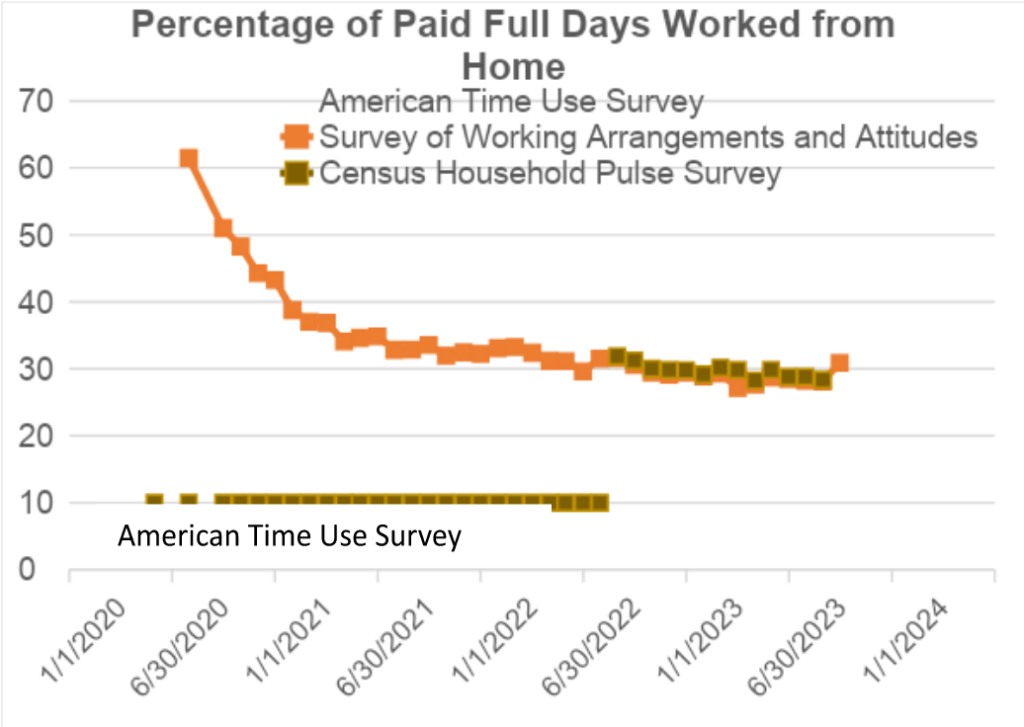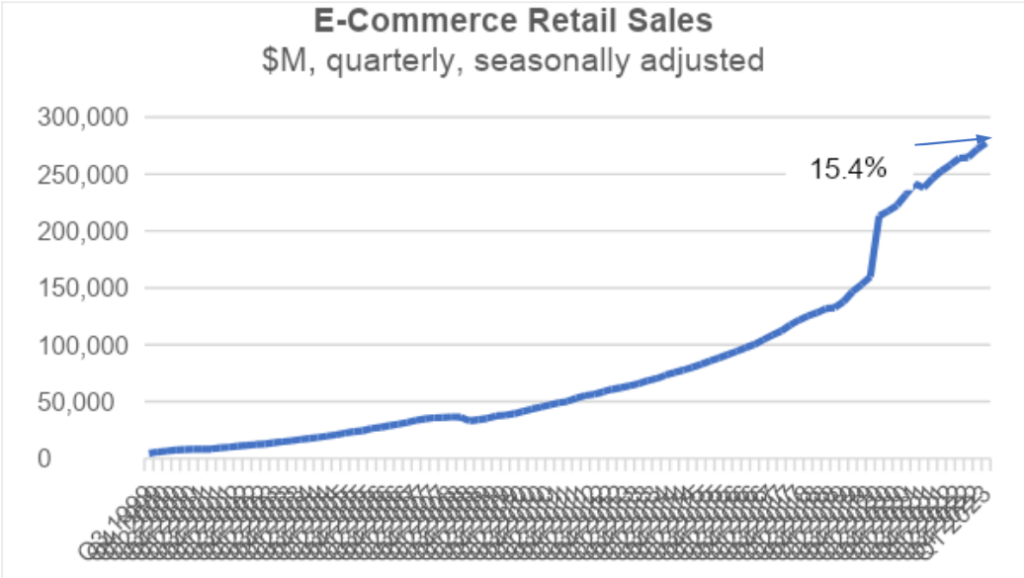The pandemic accelerated the growth of remote services and telecommuting. Now is the time for urban planners to leverage these new opportunities to reduce vehicle miles traveled.

Stakeholders in transportation have spent decades trying to influence travelers to shift their behavior from driving single-occupant vehicles to using alternative modes of transportation. We have yet to be very successful. Bike use remains very modest, primarily for recreational purposes, with its role as a commuting mode stagnating at around half a percent for years, although there is a possibility that e-bikes will move the needle. Walking comprises a significant number of trips, yet those trips are so short that they do not significantly contribute to the volume of person miles of travel. Biking and walking barely register in graphs of travel volume trends.
Even prior to the onset of COVID-19, public transit in the U.S. was accommodating about 2% of all trips, about 5% of commuting trips, and less than 1% of person miles of travel. Transit suffered a multiyear decline in ridership before being pummeled by the pandemic. Carpooling also suffered decades of decline as a commuter mode, and overall vehicle occupancies have remained relatively stable over time. Despite the evident health and environmental benefits of alternative transportation modes, the trends showed little promise of change. Various travel demand management initiatives, including commuter benefits programs, ride-matching services, and education and marketing campaigns, have had little impact–perhaps only preventing the situation from becoming worse.
In light of this, one might expect that the transportation community would seek out new ways to minimize the externalities of vehicular travel by embracing other opportunities to minimize such travel. COVID introduced such an opportunity by dramatically drawing attention to the potential to substitute physical travel with communications and computer connections. Yet seldom a word is heard about the opportunity to leverage these emerging capabilities. Whether characterized as a decision to not travel or thinking of it in terms of a choice of activity participation that substitutes a phone or computer in lieu of travel, this concept needs far greater attention within the realms of planning, analysis, and forecasting.
Internet, computer, and telephone (ICT) communications offer compelling benefits. A great deal of transportation stakeholders’ attention these days is directed toward mitigating the externalities of travel, particularly personal vehicle travel. This includes not only the high-profile attention to greenhouse gas emissions but also attention to other vehicular emissions, vehicle noise, travel-associated safety risks, and the impact of physical infrastructure on communities and the natural and built environment, including the social fabric of some communities. What better way to mitigate the externalities of travel than to avoid having to carry out the travel? The opportunity to substitute communications for travel reduces the externalities of that “would-have-been travel” to virtually zero. One might think there would be aggressive actions to leverage these opportunities. COVID supercharged the development of supportive technologies for online engagement, increased the market penetration of communications capabilities, expanded access to electronic payment opportunities, and motivated individuals and businesses to adopt and upgrade their technological tools.

The magnitude of the opportunity is indeed significant. To give it some perspective, let's play with some numbers. About 160 million Americans are part of the workforce. Assume that each works 200 days a year and would travel to and from work an average of about 10 miles in each direction (close to the average reported by the National Household Travel Survey). As shown in the figure, various data sources suggest that the post-COVID share of telework is about 30% on an average workday. American Time Use Survey data suggests it was in the mid-to-high single digits in the pre-COVID period. For simplicity, assume telework has increased its share by 20%. If all that travel were foregone (and yes, we know that some of that time and money saved on commuting is redirected to other travel, and some of the activities linked to work trips are still carried out in other trips), the savings would equal about 128 billion person miles of travel. When adjusted for mode choice (given that about 76% of commute trips are undertaken by personal vehicle or carpool), one saves about 100 billion miles of vehicle travel, or about 3% of the 3.2 trillion annual vehicle miles of travel in the U.S. In the realm of influencing travel behavior, a change of that magnitude dwarfs the composite effect that biking, walking, and transit commuting have on vehicle miles of travel.
E-commerce was another travel purpose impacted by COVID. E-commerce activity, which was already experiencing an upward trend pre-pandemic, accelerated significantly, including activities such as grocery and food delivery. E-commerce sales made up 15.4% of retail sales in the first quarter of 2023 and continue on an upward trend. While analysts will use emerging data to sort out the net VMT impacts and understand the full consequences of various delivery logistics, delivery pricing, and return policies, e-commerce growth has an opportunity to reduce travel even more.

While telework and e-commerce are the most striking examples, multiple other trip purposes are also being substituted with ICT. For example, the American Medical Association is monitoring telehealth trends, noting the spike during 2020, when 70% of patient interactions were remote, to more normalized levels of telehealth visits in 2021 that hovered in the teens to low 20% range–still an order of magnitude higher than pre-COVID numbers. Expectations in the medical community are that, as enhancements in technologies, protocols, and culture occur over the coming years, the share of virtual visits will move toward 50%. Having personally experienced an introductory telehealth visit with a newly assigned general practitioner, I found the Zoom experience much preferred. It not only saved travel time and hassle but resulted in less waiting as the discipline of a Zoom schedule enhanced the doctor’s on-time performance for my visit.
Distance learning is another area where opportunities to reduce travel will continue to arise. While educators and individuals sort through how and when to effectively execute online learning, it is likely to continue playing a significant role both in formal academic education as well as in workforce training and related activities. Distance learning is not new; I first taught graduate engineering courses via satellite uplink over 25 years ago. The newest fall enrollment data for Arizona State University, something of a pioneer in distance learning, indicated 80,000 on-campus students and 64,000 online-only students. As with other online applications, enhancements in technologies and protocols and a richer understanding of the topics, types of people, and best practices will continue to evolve, but, inevitably, more travel will be saved by virtue of distance learning.
A multitude of other personal and business transactions will gravitate to online service. Bank tellers are virtually nonexistent as online deposits, autopay arrangements, smartphone check depositing, and myriad other payment and fund transfer arrangements have minimized the need for personal interactions and associated travel. Online secure signature protocols, web camera face and ID scanning capabilities, and secure document transfers enable a multitude of business activities to be carried out via the web.
According to a Pew Research Center 2020-2021 survey, 97% of American adults have a mobile phone, and 85% have a smartphone. Along with mobile phones, Americans own a range of other devices. A desktop or laptop computer is owned by 77% of Americans, and 53% have tablets. There are about 274 million smartphones in use in the U.S. In comparison, there were 278 million personal and commercial vehicles registered in the US in 2021, and 92% of households have one or more vehicles. To the extent the availability of communication devices increasingly enables people to take advantage of online or phone-based communications in lieu of travel, communication substitutions for travel become a highly available and competitive alternative. COVID has also significantly enhanced the share of the population with some type of electronic payment capability, further facilitating remote business interactions.
The penetration of high-quality communications and Internet connectivity will only increase over time. Commitments to Internet expansion in infrastructure legislation, the aging out of the more technologically reluctant generation, and ever-improving software capabilities are destined to improve communications. Technology and communications companies are exploring myriad new devices, tools, and capabilities to enhance their capabilities and functionality. Artificial intelligence, virtual reality, three-dimensional holograms, enhanced software platforms, and other innovations may play a future role in improving communications and interaction capabilities.
The planning and transportation community should advocate for connections, technologies, procedures, and protocols that provide the greatest accessibility to carrying out activities remotely. Public agencies should do everything they can to facilitate this opportunity to enhance customer service and reduce travel demands. Frequently, public agencies lag behind the private sector in the capabilities and qualities of their online capacities. Those horrendously burdensome protocols, where one wades through multiple menus of query options, inevitably getting disconnected multiple times in an attempt to execute an inquiry, might someday be replaced with artificial intelligence-powered capabilities to discern callers’ needs from a verbal question and direct them to the appropriate menus or individuals in an efficient manner. Other initiatives, including the possibility of training and coaching internet novices, will be able to help speed up the opportunities to leverage communications in lieu of travel.
Travel is critical to societal quality of life but not all travel contributes positively to that quality of life. For one person, the opportunity to click through some computer menus and get their week’s groceries delivered can save time, hassle, and travel. For another person, a trip to the grocery store might be a rare, highly valued social outing. We need to enable ICT substitution where desirable as well as support travel where necessary and desired.
Because travel does have costs and impacts, every effort should be made to leverage the opportunity to forgo travel where it is not highly valued or economically important so that transportation capacity and resources can be directed to travel that is highly valued by the travelers. Transportation stakeholders spend a tremendous amount of energy contemplating expensive and multi-decade initiatives to upgrade transportation technologies and reshape urban environments in the interest of minimizing travel and its impacts. It is time to harvest the low-hanging fruit and leverage communication as an alternative to travel. It is an opportunity to make activity participation more available to more people, including those with limited financial resources and physical capabilities that impede their ability to travel. If ever there was a win-win solution, enhanced communications fits the bill.

Plan to Potentially Remove Downtown Milwaukee’s Interstate Faces Public Scrutiny
The public is weighing in on a suite of options for repairing, replacing, or removing Interstate 794 in downtown Milwaukee.

‘Forward Together’ Bus System Redesign Rolling Out in Portland
Portland is redesigning its bus system to respond to the changing patterns of the post-pandemic world—with twin goals of increasing ridership and improving equity.

Can New York City Go Green Without Renewable Rikers?
New York City’s bold proposal to close the jail on Rikers Island and replace it with green infrastructure is in jeopardy. Will this compromise the city’s ambitious climate goals?

700-Acre Master-Planned Community Planned in Utah
A massive development plan is taking shape for lakefront property in Vineyard, Utah—on the site of a former U.S. Steel Geneva Works facility.

More Cities Ponder the End of Drive-Thrus
Drive-thru fast food restaurants might be a staple of American life, but several U.S. cities are actively considering prohibiting the development of new drive-thrus for the benefit of traffic safety, air quality, and congestion.

Air Pollution World’s Worst Public Health Threat, Report Says
Air pollution is more likely to take years life off the lifespan of the average human than any other external factor, according to a recent report out of the University of Chicago.
Placer County
City of Morganton
HUD's Office of Policy Development and Research
Dongguan Binhaiwan Bay Area Management Committee
City of Waukesha, WI
Los Angeles County Metropolitan Transportation Authority
Indiana Borough
Write for Planetizen
Urban Design for Planners 1: Software Tools
This six-course series explores essential urban design concepts using open source software and equips planners with the tools they need to participate fully in the urban design process.
Planning for Universal Design
Learn the tools for implementing Universal Design in planning regulations.



